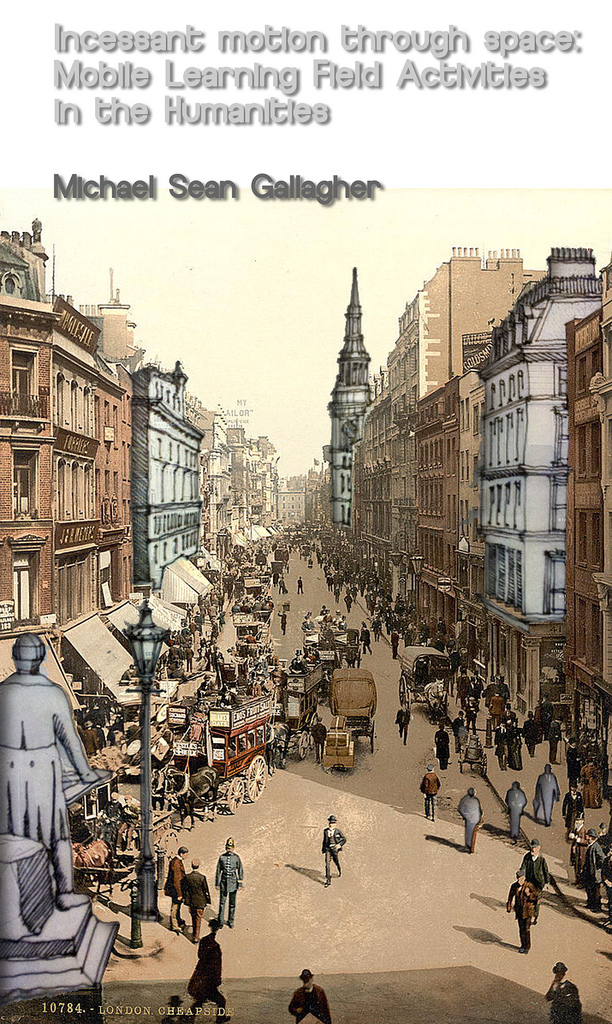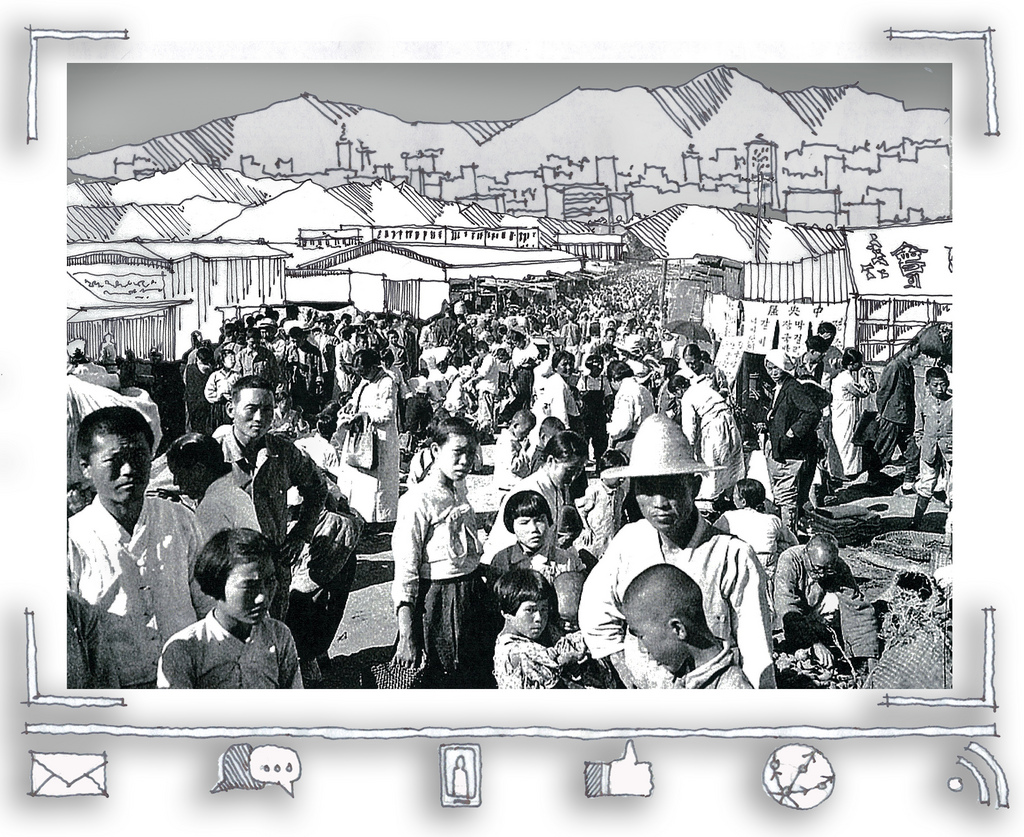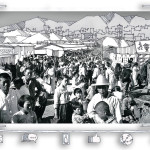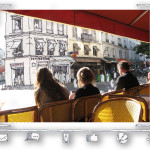
My illustrator sister and I are put the finishing touches on my ebook on mobile learning in the Humanities. A final review will take place on Monday and I will be uploading to Kindle Direct Publishing (KDP) on Tuesday. According to the information on the KDP website, it will be set to appear 12 hours or so after I upload it. I will then follow up with uploading to Smashwords for distribution to the other channels (iTunes, Barnes & Nobles, etc.). It has been an educational experience learning the details of online publishing and, in particular, the wildly disparate formats that each distribution service seems to employ. I will post more on that after I publish in case anyone had similar thoughts of self-publishing but wasn’t sure where to start.
Most of the content is now locked down so I thought it might be a good opportunity to simply outline the chapters in case anyone was on the fence or casually interested in actually purchasing the book. I am also including a few of the illustrations from the ebook in the post, all sketched by my sister Jennifer Gallagher. The title of the book is from a quote by Léon Foucault; I think anyone remotely related to academia is required by some unseen covenant to (awkwardly) use a Foucault quote or reference at some point in their careers. I just liked the quote.
I should come clean and say this book is really for teachers (and learners) and teachers who are rather experimental in their approaches at that. For those who aren’t in teaching, or aren’t interested in mobile learning, or even the Humanities, there might be less of interest or relevance to you. For those looking for a weighty academic work, this is less of that. There is some theory, but not much. This is about framing, questioning, reflection, and executing field activities with mobile technology. Since I am self-publishing, the price point is low, but since I am a poor doctoral student, it isn’t free. I hope you understand.
Chapters and Descriptions
That being said, here are the chapters with brief descriptions of their content:
List of Illustrations
The illustrations are so critical to the book, in my opinion, and so revealing on how meaning is made with disparate materials that I felt compelled to articulate exactly what images were used and how they came about.
Introduction
This, you know, introduces the book. It also establishes that a few of the chapters have addenda (just learned that this is the plural of addendum) that supplement what the chapter discussed with applied examples or further explanation.
Chapter 1: Mobile Learning
This chapter establishes my working definition of mobile learning, which has less to do with the technology and more to do with the transformation of the learner (their habitus, specifically). I think we are moving away from more technologically deterministic definitions of mobile learning and I wanted to emphasize the learner in this process of meaning making.
Chapter 2: Multimodality
This chapter basically is all the theory rolled into one package. I attempt to stress that multimodality is a good (but not the only) theory for making meaning in mobile technology and making sense of that meaning, especially in the humanities. There are thousands of other appropriate theories that I ignored altogether as I wanted to provide a theoretical framework and then get to the activities.
Chapter 3: Meaning Making: Metaphor, Mosaic, Montage
In this chapter, I emphasize how meaning is made in mobile learning, how relentless the process is, and introduce some appropriate vehicles for presenting that meaning in the humanities. I think that when working with media and text as these activities do, it is important to acknowledge that the containers for presenting meaning will vary. This is part of the evolving skill set of the learner, this knowing which container to use and how that will be received by the community.
Chapter 4: Disciplines and Informal/Formal Spaces
In this chapter, I spend some time demonstrating (I think) that learning or any sort of constructed meaning in these activities is inexorably linked to the disciplines in which the activity is founded. History is different than art than literature and so on. Each will have their own methods and means of observing and analyzing, presenting and disseminating meaning. Most importantly, the questions we use to frame the activities will begin here. Process will follow soon thereafter.
Chapter 5: Community and Place
This chapter, in parallel to the previous chapter, discusses the community and rigor of space at work in informal learning. These activities fully intend to fluctuate between informal and formal states of learning. The informal learning side of the equation presented here stresses the community of the place under observation. It is of and for people and should be treated as such. It is important for teachers and learners to understand, differentiate, and respect space and the people living in or passing through it.
Chapter 6: mField Activities
This chapter is the nitty gritty of the book, outlining the process, the questions, the reflection, and the activities that take place in any good mobile learning field activity. If I were approaching this book as a teacher, I would probably skip to this chapter and reverse engineer my way through the rest of the book on a need to know basis.
Chapter 7: mField Compositions
This chapter discusses how the data collected in the field, the text, the media, the recordings, the geopositioned data, etc. can be assembled to present meaning. These activities will generate lots of data from your learners, so it is good to have a filter or a mechanism in which to begin deciphering and assembling it.
Chapter 8: Examples & Models
This chapter provides some of my own examples on how learners can present their own meaning and some activities for some of the disciplines in the Humanities. This chapter, in particular, is much more practical in terms of providing concrete activities and outputs. Throughout all of this, I emphasize reflective practice again and again as that is the real purpose of the learning, this transformation of the learner. These compositions are a mechanism for getting there.
Chapter 9: mLearning Design
Some will have caught on by this point in the book that all of these activities are wound up in design thinking and learning. This chapter explicitly discusses how design activities are fantastic supplements to mobile learning. Getting learners to think in terms of design through research questions and process and reflective practice is a wonderful outcome of these activities. This chapter explicitly goes after how teachers can execute design activities. If you have them design it, they will own and invest in it.
Chapter 10: Tools & Resources
This chapter is in danger of being outdated before I even release it as it outlines a series of tools and resources for teachers wanting to get started with these activities. Some of these are applications, some online resources, some textual ones, but many will be mercilessly outdated by the time some people read the book. Mobile learning toolkits require constant upkeep; there is really no other way around it.
Chapter 11: Data Ownership, Privacy, and Copyright
Since so much of the book was inspired by or revolving around the illustrations, and since so many of the compositions taking place here would undoubtedly involve material not specifically generated by the learner, it seemed prudent to include a chapter on learning about copyright, fair use, and resources that can help learners navigate this confusing terrain. I stumbled through it with myself trying to track down rights to orphan works that I wanted to use. With some I managed to get permissions; with others, I had to remove from the book altogether. Learners will be faced with the same challenges and this chapter provides some basic, but sound advice for navigating copyright, permissions, and privacy.
Conclusion
The conclusion, well, concludes. However, it does so with takeaways that will hopefully reinforce the book’s emphasis on the learner and their transformation.
So there you have it. I will post again after it is available on Amazon on Tuesday or soon thereafter.



